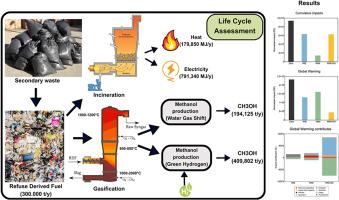气化和绿色氢气在废物管理脱碳中的潜在作用环境评估
IF 9.7
1区 环境科学与生态学
Q1 ENGINEERING, ENVIRONMENTAL
引用次数: 0
摘要
要实现可持续发展,就必须实施循环经济模式,并使废物管理部门脱碳。开发能够减少排放和回收资源的创新技术是该行业面临的最大挑战之一。从这个角度来看,废物转化为甲醇(WtM)工艺代表了一种可行的前景,但其潜在的环境影响却从未从生命周期的角度进行过研究。通过与传统的废物变能源(WtE)进行比较,对 WtM 技术及其工艺中绿色氢气(WtM-GH)的潜在应用进行了从摇篮到坟墓的生命周期评估分析。结果表明,WtM-GH 在全球影响方面表现最佳,其全球升温潜能值为 3.52-107 kgCO2eq,而 WtE 为 1,04-108 kgCO2eq。对化石资源的稀缺性也有积极影响。就无毒性区域/地方影响而言,WtE 是最佳方案,在耗水量(7.96-107 m3)和电离辐射(2.82-107 kBq Co-60eq)方面表现最佳。通过归一化得到的累积影响结果表明,WtM 是最佳方案,因为与其他两种方案相比,WtM 的毒性影响较小,特别是淡水生态毒性(5.26-106 千克 1,4-DCB)和海洋生态毒性(6.73-106 千克 1,4-DCB)。WtM-GH 可以使每吨垃圾衍生燃料生产 1366 千克甲醇,这要归功于对垃圾中所含全部二氧化碳的转化,提高了副产品和碳信用额度在市场上的价值,并使该工艺在经济上更具可持续性。本文章由计算机程序翻译,如有差异,请以英文原文为准。

Environmental assessment of gasification and green hydrogen potential role in waste management decarbonization
Achieving sustainability involves implementing a circular economy model and decarbonizing the waste management sector. The development of innovative technologies that enable the reduction of emissions and resource recovery is one of the sector's greatest challenges. From this perspective, the waste-to-methanol (WtM) process represents a viable prospect, the potential environmental impacts of which have never been studied from a life-cycle perspective. A cradle-to-grave LCA analysis was conducted, studying WtM technology and its potential implementation of green hydrogen (WtM-GH) in the process, through a comparison with traditional waste-to-energy (WtE).
The results showed that WtM-GH performs best for global impacts, with a global warming potential of 3.52·107 kgCO2eq instead of 1,04·108 kgCO2eq proper of the WtE. Positive effects take place also for the fossil resource scarcity. Looking for non-toxic regional/local impacts WtE represents the best scenario, with the best performance on water consumption (7.96·107 m3) and ionising radiation (2.82·107 kBq Co-60eq). Cumulative impact results, obtained through the normalization, found that WtM is the best scenario, thanks to the less toxic impact compared to the other two, especially for freshwater ecotoxicity (5.26·106 kg 1,4-DCB) and marine ecotoxicity (6.73·106 kg 1,4-DCB).
WtM-GH allows the production of 1366 kg of methanol per ton of Refuse Derived Fuel, thanks to the conversion of the entire CO2 contained in the waste, enhancing the value of by-products and carbon credits on the market and making the process more economically sustainable.
求助全文
通过发布文献求助,成功后即可免费获取论文全文。
去求助
来源期刊

Journal of Cleaner Production
环境科学-工程:环境
CiteScore
20.40
自引率
9.00%
发文量
4720
审稿时长
111 days
期刊介绍:
The Journal of Cleaner Production is an international, transdisciplinary journal that addresses and discusses theoretical and practical Cleaner Production, Environmental, and Sustainability issues. It aims to help societies become more sustainable by focusing on the concept of 'Cleaner Production', which aims at preventing waste production and increasing efficiencies in energy, water, resources, and human capital use. The journal serves as a platform for corporations, governments, education institutions, regions, and societies to engage in discussions and research related to Cleaner Production, environmental, and sustainability practices.
 求助内容:
求助内容: 应助结果提醒方式:
应助结果提醒方式:


